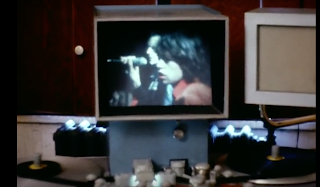My Beautiful Broken Brain (Directed by Sophie Robinson and Lotje Sodderland,2014)
- Begins with David Lynch quote
- also begins quite disorientating visually
- In and out of focus, mostly out of focus/ fuzzy
- cloud shots, city time-lapse..
- words on screen, no voices as of yet
- lots of handheld continuously (walking through park, streets, into cafe..) very point of view
- Still haven't been introduced to main ‘character’/ person of interest until about 10 minutes in
- First introduction of main woman Lotje Sodderland (co-director) is blog footage at hospital
- close ups of medical reports/hospital records
- First interview with Lotje starts normal, sound then distorts and echoes
- Vlog footage dominates a lot of the documentary, mixed with family/friends interviews
- quite a few P.O.V shots
- minimal added soundtrack throughout, quiet almost relaxing and dreamlike background sounds
- some sharp cuts from blog footage, P.O.V shots walking and interview footage with added distortion from editing (over saturation, colours heightened…)
Timelapse shot
Lotje's first appearance in vlog format
overhead shot of Lotje re-practicing spelling
one of the over saturated shots, a technique used a lot throughout
Grizzly Man (Directed by Werner Herzog 2005)
- Narration throughout entire documentary
- heavy use of Timothy Treadwell’s actual footage living amongst wild grizzly bears
- family/friends/doctor interviews
- increased immersion and sense of reality due to real footage
- no happy outcome as audience is aware of Timothy’s death prior to documentary
- Herzog likes to leave the camera rolling after finished interviews in an attempt to capture more authentic actions
Timothy Tredwell's own recorded footage
Director Herzog and friend of Treadwell listen to the audio recorded from Treadwell's camera during the fatal bear attack
Gimme Shelter (Directed by the Maysles brothers, 1970)
- Handheld ‘fly the wall’ tactic (wild horses scene) in studio with band members and others, as if audience was there with them
- Stones re-watching documentary scenes with directors, allows the audience to re-watch certain events creating a further understanding (e,g Altamont stabbing scene)
- lengthy concert videos footage of the Stones
- lots of close ups
- no voiceover (reinforcing ‘fly on the wall technique, just filming them and their audiences as if the cameras aren't there
- not a lot of interaction with the Stones and the camera
- footage of other interviews but not specific for the documentary (press interviews etc.)
- lots of stand alone footage (especially in Altamont scenes) basically letting the camera sit there and capture anything
Mick Jagger on stage performing
Press interview with the Stones
Mick Jagger in the studio listening back to their song 'Wild Horses'
Footage in the studio being watched by the Stones, directors and other crew













